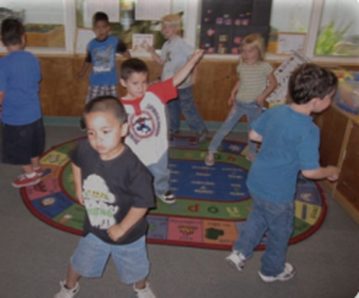10.8: Supporting Dance
- Page ID
- 153845

Dance
|
1. Safely practice simple locomotor and non-locomotor movements.
2. Explore movement in time and space using shape, size, level, direction, 3. Explore movement to encourage (kinesthetic) body awareness. 4. Explore simple phrases of movement to experience rhythm, clapping and moving to music in relationship to others. |
|
|
1. Create movements in response to sensory ideas (e.g., textures, colors, 2. Move to express different feelings in personal and general space. 3. Explore movement while moving with objects (e.g., scarves, feathers, balls). 4. Transfer same movements to different body parts and use repetition. |
|
| 1. Explore how dance expresses ideas and emotions. 2. Explore occasions for dance across different cultures. 3. Explore shapes, levels and patterns in a dance, and describe the actions. |
|
|
Indicators Children may.... |
Examples Children may..... |
|
1. Experience the joy of seeing and responding to dance. 2. Demonstrate movement to express emotion.
3. Express what is seen and felt in a movement with different tempos, 4. View a performance with attention. 5. Describe a dance in their own words. 6. Show their favorite dance move to the performers or each other. |
|
(Colorado Department of Human Services. (2021, October 26). Off to a great start. Colorado Early Learning & Development Guidelines. Retrieved August 19, 2022, from https://earlylearningco.org/)



